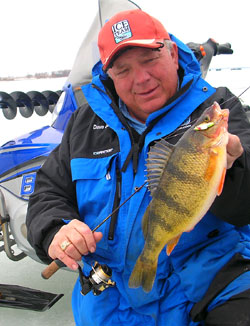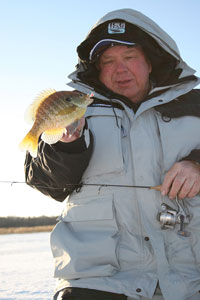 No other presentation style has had a bigger impact on ice-fishing success, and every ice angler should know how to use it.
No other presentation style has had a bigger impact on ice-fishing success, and every ice angler should know how to use it.
In nature, fish eat prey items that swim and dance.
In nature, prey items move with realism, pulsating quickly, squirting one way and then another, often seeming to vibrate in place rapidly, often doing so as they drift slowly either up or down in the water.
You can learn to imitate these rapid vibrations while ice fishing, and it will greatly increase your catch rate.
Many ice anglers only use a soft, slow, rhythmic swimming motion while presenting lures and hoping for bites. Sometimes that works.
Most days, you will catch more if you have mastered the pound.
Presenting the Pound
It’s called the ‘Genz Pound’ or just ‘pounding,’ and no other presentation style has had a bigger impact on ice-fishing success, and every ice angler should know how to use it.
It’s sometimes called an aggressive presentation, but it isn’t aggressive so much as lifelike. In fact, your jig doesn’t often move long distances, because you are not pumping hard up and down.
There are degrees of aggression you can build into a pounding presentation, and to some extent, it matters whether you are using a jig with a vertical or horizontal orientation. Look at the photograph and you will see the difference between a vertical and horizontal jig.
Nothing in fishing is absolute, but Dave Genz generally believes that a horizontal jig looks more realistic to a fish, because it better represents a prey item that is swimming– horizontally– in the water. Vertical-hanging jigs, because they probably don’t look as realistic to a fish, need to be fished aggressively in order to more consistently trigger bites.
“It’s a little more complicated than this,” says Genz, “but a horizontal presentation can be used to trick fish. It really helps you catch fish that are lethargic and only respond to a bait after they get a chance to slide up and examine it.
“A vertical presentation is often used to trigger fish that can be almost forced to hit aggressive jigging. I keep (a vertical-hanging jig) moving all the time, because I don’t want the fish to get a good look at it.”
The Genz Pound is executed by moving your wrist rapidly up and down, but not moving it ‘far’ with each ‘pulse’ you create. “It looks like you’re nervous,” says Genz, “when you’re doing it right. The effect you are going for is that your jig is vibrating in the water.
“A lot of times, you also want to move the bait up and down, in order to search through different depth levels, but you do that by raising or lowering your arm as you do the pound.”
The pounding presentation was developed for use with a vertical-hanging jig, but it is also extremely effective when used with a horizontal jig. In fact, the realism inherent in horizontal jigs is greatly enhanced through a relentless, vibrating rendition of the pound.

Here is the dynamic at work when you get it right:
The eye of the jig is the pivot point, and the ‘tail’ portion (the hook point) kicks up and down like a horse’s rear legs bucking. “You don’t want the entire jig to move up and down in high hops,” says Genz. “The pivot point is just that; it doesn’t move up and down much.”
With a horizontal jig, the resulting action looks extremely lifelike. It seems to almost hum with realism and pulse with life. It brings fish in and convinces them to suck in your bait.
“There are other ways, that people have come up with over the years, to achieve this pounding style,” reports Genz. “Some people hold their rod in one hand, or lay it on their leg, and bang on it rapidly with their other hand, and that can make the jig look alive.”
How to Grip the Rod
To produce the Genz pound the way he does it, try his ‘pencil grip’ on the rod handle.
Many top-notch ice anglers use it. Rather than gripping the rod in the traditional manner, you essentially grab onto it from ‘over the top,’ or sort of cradle the reel in your hand as if you are rocking it to sleep.
(After you take this grip, you can hold it in an ‘overhand’ position, or turn your hand so palm is facing upward. By experimenting with hand positions, you’ll find what works best for you, and will learn to vary it to achieve different presentations.)
“The big reason you do it that way,” says Genz, “is that it takes your shoulder out of it when you set the hook. It’s all wrist now. You’re set to come up real quick with your wrist. You can set the hook into that fish’s mouth before he can spit it out.
“That moves the rod tip as far, or farther, than when you pull up with your shoulder and smash into the roof of the Fish Trap. And it’s way faster.”
For hooksetting advantages alone, the new way of gripping an ice rod is better. But, says Dave, you will also come to appreciate the presentation advantages, too.
“It feels funny to do it this way, at first,” says Genz, “but the action you can get on the jig is worth spending time at it. Get comfortable and it feels weird to do it the old way after a while.”
Learn to master the pound, and you will get a lot of practice setting the hook.
Note: Dave Genz, known as Mr. Ice Fishing, was the primary driver of the modern ice fishing revolution. For more, including his instructional DVD on bluegill fishing, go to www.davegenz.com and www.iceteam.com.










